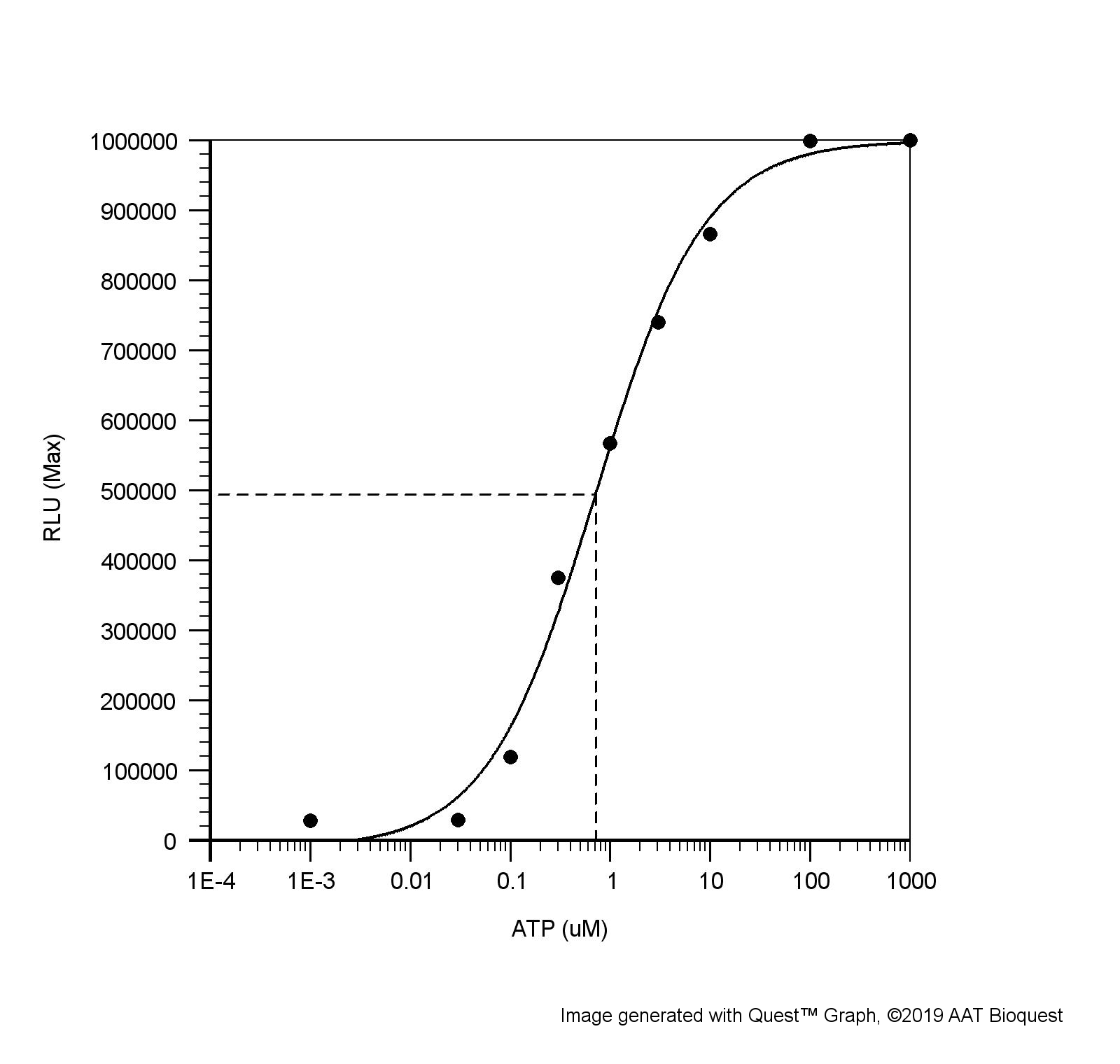上海金畔生物科技有限公司代理AAT Bioquest荧光染料全线产品,欢迎访问AAT Bioquest荧光染料官网了解更多信息。
Screen Quest 发光法钙离子检测试剂盒
| 货号 | 36306 | 存储条件 | 在零下15度以下保存, 避免光照 |
| 规格 | 100 Plates | 价格 | 31812 |
| Ex (nm) | 437 | Em (nm) | 466 |
| 分子量 | 溶剂 | ||
| 产品详细介绍 | |||
简要概述
钙通量测定法是药物发现中筛选G蛋白偶联受体(GPCR)的首选方法。该试剂盒使用高度钙敏感和膜通透的腔肠素类似物作为用载脂蛋白基因转染细胞的钙指示剂。水母发光蛋白是来自维多利亚水母的钙敏感生物发光蛋白,已广泛用作细胞中的钙指示剂。当与钙离子结合时,水母发光蛋白复合物发出蓝光。发光强度与Ca 2+浓度成正比。我们的腔肠素试剂盒比荧光钙测定试剂盒(如Fluo-4,Fluo-3,Calcium-3和Calcium-4)灵敏得多。该试剂盒提供了一种优化的测定方法,用于检测G蛋白偶联受体(GPCR)和钙通道。该测定可以使用96孔或384孔微孔板进行,并易于适应自动化。金畔生物是AAT Bioquest的中国代理商,为您提供最优质的Screen Quest 发光法钙离子检测试剂盒。
钙离子篇:时间轴式讲解应用于钙离子检测的探针
适用仪器
| 发光酶标仪 | |
| 推荐孔板: | 黑色透明 |
| 读取模式: | 底读模式 |
产品说明书
样品实验方案
简要概述
- 通过去除生长培养基制备细胞
- 加入腔肠素装载溶液(对于96孔板为100 µL /孔,对于384孔板为25 µL /孔)
- 在室温下孵育3-4小时
- 检测水母发光蛋白的发光强度
溶液配制
储备溶液配制
1.腔肠素类似物:将250 µL 100%ETOH(组分B)加到腔肠素类似物(组分A)的小瓶中,并充分混合。 注意:25 µL重组腔肠素类似物对于一块板就足够了。 如果将试管密封,则未使用的腔肠素类似物原液可在<-20℃下保存一个月以上。 避光并避免重复的冻融循环。
2.分析缓冲液(1X):a)对于#36305(10板试剂盒),准备使用1X分析缓冲液(组分C)。b)对于 #36306(100板试剂盒),通过将10 mL的10X分析缓冲液(组分C)稀释到90 mL的HHBS缓冲液(试剂盒中未提供)中,制成1X分析缓冲液,并充分混合。 注意:10 mL 1X分析缓冲液足以用于一块板。 将未使用的1X分析缓冲液存储在4℃下。
工作溶液配制
腔肠素装载溶液:将25 µL ETOH重构的腔肠素类似物(储备溶液制备)添加到10 mL 1X分析缓冲液(储备溶液制备)中,并充分混合。 注意:该工作溶液在室温下至少可稳定2小时,并避免光照。
实验步骤
1.从细胞板中去除生长培养基。 注意:重要的是去除生长培养基,以最大程度地减少化合物对血清或培养基的干扰。 注意:将细胞在含0.5-1%FBS的生长培养基中培养,以避免去除培养基的步骤。 在这种情况下,需要在1X缓冲液中装载2X腔肠素。
2.将100 µL /孔(96孔板)或25 µL /孔(384孔板)的腔肠素加载溶液添加到细胞板中。
3.在避光的条件下,于室温下孵育腔肠素装载板3-4小时。
4.用HHBS或所需的缓冲液准备复合板。
5.通过使用具有光电倍增管的封闭腔室的光子检测系统,检测水母发光蛋白的发光强度。 仪器必须完全排除外部光线。
图示
 图1. CHO-aeq细胞上的ATP剂量反应。 用载脂蛋白精稳定转染的CHO细胞以50,000个细胞/ 100 µL /孔接种在Costar白色96孔板中过夜。 除去生长培养基,并使用Screen Quest 腔肠素钙测定试剂盒将细胞与100 µL染料上载溶液一起在室温下孵育3小时,并避光。 由NOVOstar(BMG Labtech)添加ATP(25 µL /孔),以达到最终指示的浓度。 ATP的EC50约为0.8 µM。 |
相关产品
Bioluminescence Resonance Energy Transfer (BRET) Assay for Determination of Molecular Interactions in Living Cells
Authors: Harikumar, Kaleeckal G and Yan, Yan and Xu, Ting-Hai and Melcher, Karsten and Xu, H Eric and Miller, Laurence J
Journal: (2017)
Intracellular Ca2+ is important for flagellin-triggered defense in Arabidopsis and involves inositol polyphosphate signaling
Authors: Ma, Yi and Zhao, Yichen and Berkowitz, Gerald A
Journal: Journal of Experimental Botany (2017)
Orchestration of salivary secretion mediated by two different dopamine receptors in the blacklegged tick Ixodes scapularis
Authors: Kim, Donghun and Simo, Ladislav and Park, Yoonseong
Journal: Journal of Experimental Biology (2014): 3656–3663
Blue fluorescent protein from the calcium-sensitive photoprotein aequorin: catalytic properties for the oxidation of coelenterazine as an oxygenase
Authors: Inouye S, Sasaki S.
Journal: FEBS Lett (2006): 1977
Crystal structure of obelin after Ca2+-triggered bioluminescence suggests neutral coelenteramide as the primary excited state
Authors: Liu ZJ, Stepanyuk GA, Vysotski ES, Lee J, Markova SV, Malikova NP, Wang BC.
Journal: Proc Natl Acad Sci U S A (2006): 2570
Expression, purification and characterization of calcium-triggered luciferin-binding protein of Renilla reniformis
Authors: Inouye S.
Journal: Protein Expr Purif. (2006)
Extended bioluminescence resonance energy transfer (eBRET) for monitoring prolonged protein-protein interactions in live cells
Authors: Pfleger KD, Dromey JR, Dalrymple MB, Lim EM, Thomas WG, Eidne KA.
Journal: Cell Signal (2006): 1664
In vivo testing of Renilla luciferase substrate analogs in an orthotopic murine model of human glioblastoma
Authors: Otto-Duessel M, Khankaldyyan V, Gonzalez-Gomez I, Jensen MC, Laug WE, Rosol M.
Journal: Mol Imaging (2006): 57
Luminescence of imidazo[1,2-a]pyrazin-3(7H)-one compounds
Authors: Teranishi K.
Journal: Bioorg Chem. (2006)
Mitochondrial adaptations within chronically ischemic swine myocardium
Authors: McFalls EO, Sluiter W, Schoonderwoerd K, Manintveld OC, Lamers JM, Bezstarosti K, van Beusekom HM, Sikora J, Ward HB, Merkus D, Duncker DJ.
Journal: J Mol Cell Cardiol (2006): 980
